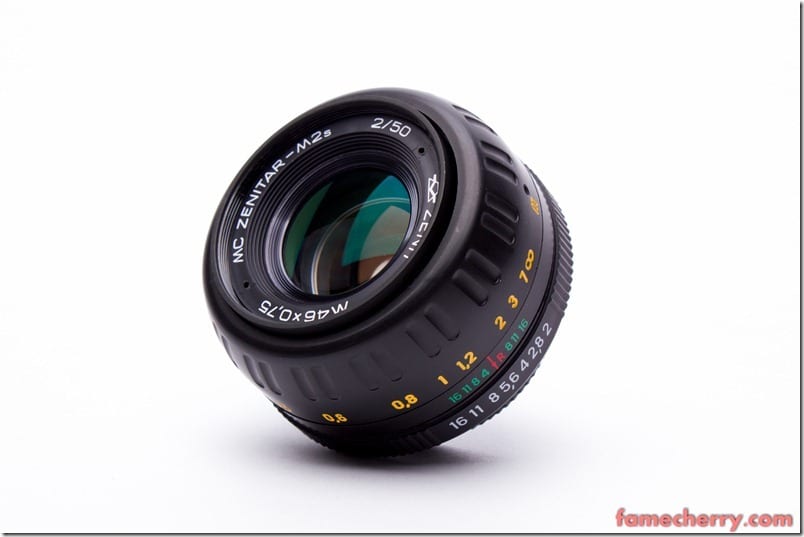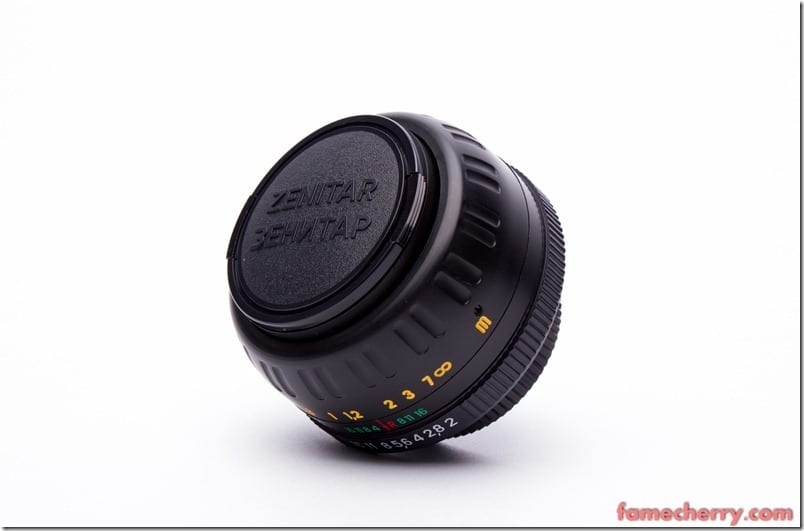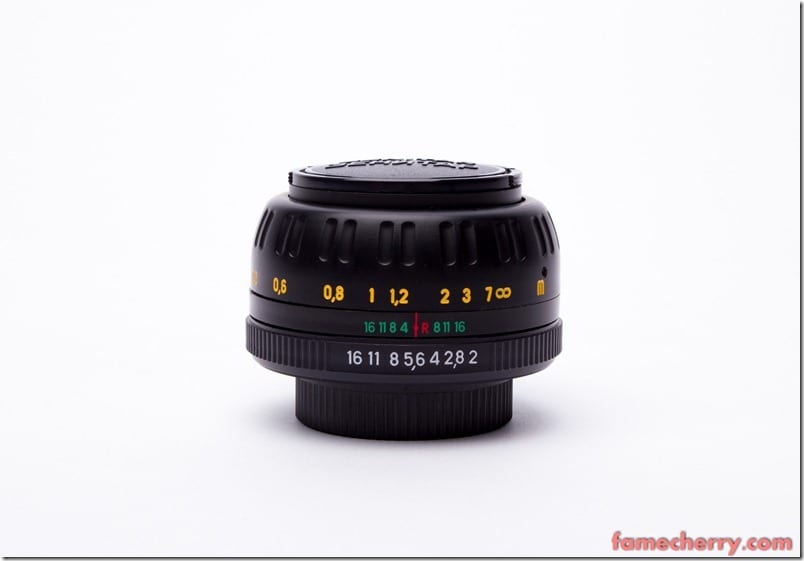Promotional Price : RM 299 RM 199 ( We also accept payments in SGD )
Available Mounts : Canon, Nikon, Sony, Pentax, NEX, M4/3, M42, Fuji, Samsung
Special Characteristics : Sharp Wide Open Even At Corners, Swirly Bohkeh
Purchase Options : Shipping Available To All Parts of Malaysia, Self Pick Up Is Available at our branch in Cheras
Optional Accessories
Full Metal Lens Hood : RM 19
Join The Zenit Worldwide Community : https://www.facebook.com/groups/zenit-world
Orders & Enquiries
Please email us at shops.famecherry@gmail.com or call us at 012-3375629
( We are also available on Whatsapp but if urgent please make phone call ya )
Manufacturer : Zenit
Technology : Carl Zeiss
Focal distance : 50mm
Aperture : F2.0
Field angle, (diagonally the frame) : 45 Degrees
Number of lenses/elements : 6/4
Minimum shooting distance : 0.35 m
Overall dimensions : Ø 66×43.4 mm
Weight : 140g
History
Zenit is a Russian (and formerly Soviet) camera brand manufactured by KMZ in the town of Krasnogorsk near Moscow since 1952
Founding and post-war years
After the German invasion of the Soviet Union in World War II, the Red Army had acute need for precision optical instruments. The existing factories were either inaccessible, such as LOMO in besieged Leningrad, or overloaded with demand, such as FED which had just been evacuated from Kharkiv to Berdsk. The KMZ factory was set up in 1942 near Moscow, which by then was no longer in immediate danger from German troops, on the site of a recently evacuated mechanical plant. Initially the company took over production of scopes and binoculars as well as reconnaissance cameras.
After the end of the war, KMZ began producing photographic lenses in 1945 to the specifications of the Carl Zeiss corporation, whose factory in Jena had been overrun by the Red Army and largely carted off as war reparations. In the post-war years KMZ also began producing the Zorki camera, a close copy of the German Leica II and the Soviet FED, as well as copies of Zeiss medium-format cameras under the name Moskva. These mark the beginning of consumer production at KMZ besides the original military focus of the company. During the following years, KMZ was the main supplier of photographic lenses in the Soviet Union.
1950s and 1960s: Years of creativity
The mid-1950s saw the beginning of a period of heightened R&D activity at KMZ. One reason was that lens production could be offloaded to a number of other new optical plants, including Arsenal in Kiev which began producing lenses in 1955. This freed up valuable resources at KMZ. Another reason was the changed economic policy under Nikita Khrushchev, which placed more emphasis on producing consumer goods, such as cameras, instead of investment goods and heavy industry. As a result, KMZ produced several highly interesting concept cameras that won international prizes at fairs such as the 1958 World Exhibition in Brussels.
The company’s Zorki line of rangefinder cameras underwent significant modifications that moved it gradually from being a direct Leica copy towards an original camera line of its own. Several other highly interesting rangefinder camera lines were developed out of the Zorki in the early 1960s and put to market in relatively small numbers. However, the most influential camera developed during this period was the Zenit, a single-lens reflex camera based on the Zorki rangefinder body. The Zenit line was presented in 1953, and of the first generation of Zenit cameras, more than 1.2 million units were produced until the end of the 1960s. A major redesign was presented in 1967 that made the line compatible with the M42 lens mount that was in use worldwide.
In 1965, KMZ also began producing movie cameras, of which was the Krasnogorsk series for 16 mm film was the most well-known. During this time, there was substantial cooperation between the military and the civilian sections at KMZ; an example of this is the Horizont panoramic camera of 1967, which was developed out of an older artillery camera and continues to be produced in modified fashion to this day.
1970s and 1980s: Catering to the domestic market
he pace of R&D for consumer products at KMZ substantially slowed down at the end of the 1960s. One reason for this might have been the relatively low output figures. Since large amounts of resources were channeled towards research and development, production figures itself were low. Under the conditions of the Soviet planned economy, these absolute production figures tended to be the main indicator for a company’s productivity, which made it somewhat undesirable to invest in research and development. Another reason may have been the changed economic policy under Leonid Brezhnev, which again focused increasingly on heavy industry and arms production.
During the 1970s consumer production at KMZ shifted towards producing large numbers of individual, relatively simple models of the existing product lines. These still underwent smaller modifications and innovations, but there was a clear focus on mass production. The Zorki line of rangefinder cameras was continued until 1980 with a single model dating back to the 1956, of which 2.2 million were produced with some modifications. The Krasnogorsk-3 movie camera was produced in a largely unchanged fashion from 1971 to 1989. The Zenit line of SLRs saw somewhat more substantial modifications, such as the addition of light metering, but here too the focus was primarily on mass producing tried-and-true models, rather than implementing technical innovations such as automatic exposure that had been standard in the West for almost a decade before they appeared on the Zenit. To cope with domestic demand, Zenit production was outsourced to several other camera works in the Soviet Union as well. More than 6 million Zenit cameras were produced at KMZ until the end of the 1980s, but by that time the Zenit comparatively outdated. During this time, the relative importance of the military section of KMZ grew, in response to the increasing focus on arms production in the USSR in general. KMZ also developed a major focus in metallurgy, mechanical engineering and optoelectronics.
Lens Review
https://arqiufotografi.wordpress.com/a-pessimist-review-of-zenitar-50mm-f2
Sample Photos & Video
http://35photo.ru/items/russia
http://www.lifeisphoto.ru/search.aspx?select=zenitar50
http://www.youtube.com/watch?v=skSs_u3GsPo
Sample Video
Music Video Scenes credits to the Zenitar 50mm f2.0 ( Fence, Train Station ), Mitakon 85mm f2.0 II ( Park ), Mitakon 135mm f2.8 ( Park )
Snapshot of Video In Progress
Hands On Field Test ( Shot Wide Open )























is there any AF or Focus-Point confirmation(electronic contacts) available?
The lens is manual focus
Focus confirmation got for Canon mounts
For my shots I used LCD zoom 10 x then only focus to make sure their spot on
U have email
how much for this of canon mount with af ?
Yes Canon mount got focus confirmation
RM 199
do u meant by canon/nikon mount via an adapter or specifically made like tamron/sigma except with no AF?
U’ve got pm =)
may i noe this lens can use on Canon FF or apcs onli ?
And need adapter?
New item or 2nd hand?
Thx..
Can use for both
Everything come together already so no worries
Brand new, we only sell brand new products
can use for EP3?
Can
cant i now your branch in Chera address .
U’ve got mail =)
branch pls
U got email
hello?
is that only 50mm F2.0 for sale only do you sell 50mm F1.4 ?
Factory only make F2.0
please send detail to my email on this product and also flash light that suitable for canon 1100D my email namhto80@gmail.com
Ready stock =)
U got email
namhto80@gmail.com please send me detail ASAP and dont forget the flash light price too…
what is your address @ cheras?
pm me the detail spec for nikon
Can use with Nikon camera yes
every nikon model or just certain model? like me for example i am a user of D90… does this lens match with my DSLR?
Every nikon model
Yes can use with yours
You got email
no need adapter? af? good for video rebel kissx4?
Come together already
Yes good for video for your camera
can use for nikon d3100??
Yes can =)
can use for nikon d3100??
Hi FAME CHeRi, can use this lens on M4/3 Camera? like Panasonic GF1, GF2?
Yes it can be used
Zenitar 50mm f2.0 Russian Lens…can fix for nikon d5000…??
Yes its compatible for your camera
Zenitar 50mm f2.0 Russian Lens…can fix for nikon D5000…??
can i get the detail for this lens also steadicam?
Which details do you require ?
This lens is portrait lens suitable for Canon, Nikon, Sony, Pentax, M42, M4/3, NEX
Steadicam meaning the motionpro stabilizer ?
both, stabilizer and that 50mm lens for nikon
Lens is ready stock
Stabilizer if new version mark 2 you ok ?
Please give me your email or whatsapp
pm me haziqdny@yahoo.co.uk
U have email =)
Can use for samsung nx200 ?
U have email =)
suitable for samsung nx10?
Are all samsung mounts the same ?
ya…i think all the same…so? suitable?
Zenitar 50mm + Sony Alpha Adapter price pls. TQ.
RM 199 =)
Address pls
U have email
yg ni ade autofocus tak?
Its a manual focus lens
PLEASE GIVE ME YOUR SHOP ADDRESS
U have email =)
mssinaran@gmail.com
Thank you
I would like to know if this lens is only for manual focus…Is it compatible with sony alpha dslt or it needed a adapter? Is there ready stocks? PM me..thanks
Yes manual focus, from my experience manual focus usually is sharp even on the side for rule of third composition. Autofocus lens usually only centre sharp unless you buy those high end expensive lens
Yes compatible
Yes ready stock
You have email
suitable for nikon D5100?
pm me the detail spec for nikon
akuyahaya@yahoo.com
Yes suitable
You have email =)
Email me your Shop Address please?
U have email =)
Just got my Zenitar 50mm f2.0 lens cod at cheras branch today,
nice seller easy and fast and provide good service,
definitely will deal with u again ya good day thanks.
hehe cheers mate, enjoy your new item !
Thank you so much !
hi i need to buy some equipment but can i try before buy where is your branch in cheras thanks.
Sure
We in Cheras Bdr Tun Razak
sample photo yg u ambil sure pakai lens ni? manual focus right, what about d aperature? manual also or?
Yes taken using this lens
Everything manual =)
I’m interested in getting the 50mm f2.0 lens Russian Zenitar Lens for Canon 1100D ..
Yes its compatible =)
does it need other adapter to b able to connect/mount it to canon 1100d? or it is ready to go/mount?
Everything already come together so can just plug and play ! =)
You no need to worry any thing at all
is it compatible with Nikon D3200
Yes absolutely =)
HI, does this lens come with an adap tor for Sony NEx camera ? I am using Sony Nex6
thanks
Yes can use with your camera =)
Sony Nex got peaking mode
can use with Nikon D3000? Manual or auto focus?
Can be used with your camera
Manual focus =)
hi, is this in M42 mount? what would the shipping be like for Kuching, Sarawak. Also, did you mention this is “NEW”??
You got email =)
Yes its new
this lens can use for nikon3100 ??
Yes can
for mikatkon 85mm f2.0 II can use for nikon d3100 ?? manual or auto focus?? is it dot warranty??
Yes can
Manual
1 Year warranty for manufacturing defects
how can i pick it(nikon mount with lens hood) up by myself? can u email me the actual price and your address?
Ready stock
Actual price is as listed with no hidden charges, deviation or deception of any kind ! Its really RM 199 only ! =)
U have email
Hi,how much the cost to Kuching Sarawak?the ‘bokeh’ is originally from this lens?..if can,pls inbox the picture – lens with hood…tq:)
Yes the bohkeh is original from this lens without alteration
You have email
Hi can i have more information on this item for Nikon D3000?
is it suitable for nikon D3000?
how can i pick it(nikon mount with lens hood) up by myself? can u email me the actual price and your address?
Hi, Way Siong here
may i know this lens still available?
im interested
Thanks
Ready stock =)
Ready Stock
U have email =)
Hi can i have more information on this item for Nikon D5100?
U have email
well this is interesting never try before this russian lens….u got adapter for canon 60d?
can u email me joecore90an2@gmail.com…canon 60d
Email sent =)
hi..may i know this lens can use for nikon d3100?
and let me know ur branch address plss..coz i prefer go to ur branch..hEe~ :)
this is my email.. ajeeb747@yahoo.com
U have email
send to ur address
hi , can use for sony nex? need adapters?
Yes can use
U have email
is it mountable for sony a550 ??
Absolutely ! =)
Zenitar 50mm f2.0 Russian Lens…can fix for nikon d7000…?? PM me plzzz..amir_5142@yahoo-5KVGLVFVTHJOHZVIP3VYZWDFPQ:disqus .com
Thank you so much ! =)
HI can i use with nikon d3200 ?? and shop location pls mohanad.altaai@gmail.com
Yes can
U got email =)
Zenitar 50mm f2.0 haf focusing motor? is it suitable for nikon 5100?
This lens is fully manual focus bro
Yes
Just got this today, the pictures are so sharp and the bokeh is so good… thanks a lot!!!
Enjoy your new item !!! =)
got motor or not?
Manual focus
Is there still promotion price? for D3100.. azryzainuddin@yahoo.com
U got email =)
yes got
hi…i want to know that zenitar 50mm f2.0 lens available for canon 600D???
and i want to know that the promotion is until when???
Yes got
Promo period decided by factory
Can send me full details on this lens? Also ur shop add??my email is carrotjian_1991@hotmail.com
U have email
hi..is this lens still available?
Ready stock !
Hi, can you send me the details?
U have email !
besides 50mm f2 does Zenitar hv any othe range of lens eg 100mm f2?
Maybe later if factory decides to relaunch =)
do you have stock for 50mm? wanted to use for d3100 nikon. my email iskandarmahmud@yahoo.com
Yes ready stock
U got email =)
Do u hv the Helios 58mm f2 in a-mount?? as i saw an old m42-mount lens…
I have tested the Helios 58mm f2 that day, the Zenitar 50mm is sharper than that lens when i ran a side by side
But yeas, we do have the a-mount for Zenitar 50mm
May i know this 50mm can be fit in Nikon D3100? any stock (cymee123@gmail.com)? can email me the price with Nikon Mount + Full Metal Lens Hood?
Thank you for choosing us ! =)
Can Fit Nikon V1 or Nikon D3200??
Yes can fit =)
how about with eos 60d??
Yes it can fit 60D
is this can fit with Canon 500D ? is this available?
Yes it can
yes it is
can this lens work on metering for nikon d40
yes can
this lens still available?
Yes it is
Please PM me …. Akoi (shahrulakoi@yahoo.com)
Thank you
do this lens can fit to nikon d90?
Yes
can fit with nikon D90?
Yes it can fit
can fit with Nikon 60D?
Yes can =)
still valid?
Yes it is =)
Can have your Cheras address please?
U got email =)
what is your address @ cheras? pm me asap fareedkadir@yahoo.com
U have got email =)
helo tauke..ive already transfer rm209 to ur account and ive sent the details to ur email this morning. please reply my emel.. tq tauke
can use for nikon d3000??
Please PM Me TQ (shahruakoi@yahoo.com)
Yes =)
U have email
canon 550D blh masuk tak? cheras di mana?
Boleh
U got email =)
built in non-motor, right?
It is fully manual focus using hand
is it still available?
where is your shop location, can we COD around KL
Yes ready stock
U have email =)
hello, can u send me the detail please?
boyunder18_jay93@yahoo.com
thanks :)
U have email =)
I need one with nikon d5100 mount..same price right?
pm me :)
Thank you
Yes same price
U have email =)
this lens can fix on Nikon 1 J1 ?
Yes can
i nk oder
Ready stock =)
how much for canon mount?
RM 199
can be put on canon eos 60D ?
Yes absolutely can
can use on sony nex? the lens will come with adapter?
Yes can use
Yes come together
can be put on canon dslr eos 7D?
are all this lenses can be put on eos 7D?
Yes all our lenses can be used with your 7D
Yes absolutely
whr can buy it
Ready stock =)
U got pm
how much for one with mount for sony alpha courier to Johor?
You have email =)
Hello, Can it be use with Samsung NX1000 Camera? Or do I need a lens mount for it? Thank you.
BTW, I also have a Canon 700D, thus want to know if the lens also fit for canon dslr? Or I have to buy separate lens for each camera? Thank you.
Yes can use absolutely
No need to buy seperate lens, same lens can use all bodies
Yes can use
U have email =)
Still available? Can use for SOny A57? pm me in detail the spec..
Yes
Yes
thank you so much for choosing us ! =)
Can used with Sony NEX C3 ? kamerim@yahoo.com
Yes can =)
U got mail
still available ? can it be use for olympus ep3 ?
ready stock =)
yes can =)
shop address?
U have email =)
can i buy it from online..
for nikon D90 ?
Yes, u got email =)
is there any af adapter for sony alpha??
AF confirm u mean ?
Sony @33 can use Zenitar 50mm f2.0?
Yes, absolutely =)
Address branch in Chera. tq
U got email =)
Hi, what is the pricing include with Canon DSLR mount, ex stock?
U got email
Stock is brand new direct from factory
hi? can u send me the detail please?
yapyap_chin@hotmail.com
I am using Sony Nex5
thanks :)
Yes ready stock
Yes can use on your Nex
You got email =)
is include with Nex adapter??
Yeah
Thanks~
Cheers
PM me . Include the adapter or not?
Yes included
U got email
hye,, could u PM me..im using canon 550d..
Thank you, u got email =)
is there any warranty for this unit?
Yes got, 1 year warranty for manufacturing defects
can this lens fix into nikon D3200 ?
Yes can
Can it fit my nikon d5100? Does it come together with lens cap?
Can it fit my nikon d5100? does it come together with a lens cap?
Yes can use
Yes got lens cap
Zenitar 50mm f2.0 Russian Lens are this m42?
We have available Mounts : Canon, Nikon, Sony, Pentax, NEX, M4/3, M42, Fuji, Samsung, Minolta
[…] 50mm f2.0 K-mount Essential Studio Equipment : Zenitar 50mm f2.0 Russian Lens ( Carl Zeiss Technology, Helios 50mm Suc… xtwis7 wrote: Wah, can share what is this lens? Never seen before. HOLYMOFO wrote: keen […]
[…] to see dis~ oooooo..cheap lens like so fun~ Essential Studio Equipment : Zenitar 50mm f2.0 Russian Lens ( Carl Zeiss Technology, Helios 50mm Suc… http://deluxeforums.hardwarezone.com…~-4358758.html __________________ ✖Sarpork moi […]
how much for this lens with nex mount?
RM 199 =)
Is this lens able to run AF with D7000 AF in -built motor?
let me know the best price with the availability plus the delivery period. Deliver to JB.
U have email =)
can be used with nikon D40? what about autofocus?
how long for delivery to sarawak?
Yes can, manual focus
Poslaju after they pick up arrive in 1 working day time under normal circumstances
please PM me your address…
U got email =)
Sony Mount available? Can COD?
Ready stock
U got email =)
still available 50mm F2.0? It is ok to use for alpha 390? and provided mouth + shipping = RM199?
Warranty and etc? Pls provide more information and thanks.
Ready stock, yes can use for Sony
Warranty 1 year for manufacturing defects
U have email =)
chanchunchien@hotmail.com
Appreciate for your prompt advise and awaiting for more information.
Thanks.
I have sent u email =)
Please have a look ya
I want this lens..
this is m42 lens or not?
do emel me at anwaridrus28@gmail.com
U got email =)
Is it compatible wif D5100?
Whr is ur cheras branch?
U got email =)
May I know the price include postage? let say, posting to Sarawak?
U have email =)
Pm kalemerah@gmail.com..phone number please..
Essential Studio Equipment : Zenitar 50mm f2.0 Russian Lens ( Carl Zeiss Technology, Helios 50mm Successor )
0123375629
Ready stock
is it compatible with canon 650D? w/o using adapter?
U got email
Hi, is the lens adapter included for the price RM199?
And is it fully compatible with Sony NEX-F3?
Please quote me the details and delivery price to Seremban, NS
email: matrixvinc@gmail.com
TQ
U have email =)
Do you sell this with the respected adapter? Say, i need one with nex mount, is it covered with the price?
Adapter is free
U got email =)
can i use this lens on olympus om 10 and sony nex?
U have whatsapp message =)
sony mount still available? i want it with Full Metal Lens Hood
ready stock =)
nice meeting u bro
can use for Nikon D60 ?
yes can use
how to make a order ? i need 1 to try if can use for D60. is manual n for portrait ? no need adapter in between ?
Yes full manual focus using hand
Yes suitable for portrait
U have email
I’m interested in this lens for its spiral bokeh. but i’m only using apsc.since it’s crop, im not sure if the result is the same.can u post some nice sample with apsc sensor?
It will be the same
You have email
Tq
Manual Focus?
You have email
Hi, may I know 50mm lens and 85mm lens, both can create the same effect of “swirl background”?
please pm me your address..txs.
Zenitar 50mm and Helios 85mm both have swirley bohkeh with varying intensity due to focus length
You have email
60d n d7000 can fix
Yes can use =)
Is it sutable for Nikon 5100 .If so how much for this ? Af lens ?
Prakash.wnd@gmail.com
U got email =)
How to mount this one with my nikon d5100. Also do you send to SG?
U have email =)
need to use adapter for nikon n canon?
U have email =)
Where can i get the adapter?
U got email =)
Cost to ship to Singapore?
U got email =)
Do you ship to Thailand ?
U got email =)
info@changthai.com Please send detail..
U got email
Can it be using on Olympus EP3?
U got email =)
Hi, the Zenitar 50mm F2 has different mounting option? or it does comes with the adapter?
do you have option to include adapter that enable me to mount it both on nikon + fuji mount?
U got email =)
Can used at Nikon D7000?
Email sent to your inbox =)
hi, is the lense fit with sony nex5? price with af? thx.
U have email =)
Thank you
kindly email the spec for this lens, and is it compatible wit 7D.. thanks..
U got email =)
can i use this on my gx1 ? i need a converter for this ?
Yes can use, everything u need we already give u so no worrie
U got email =)
hi bro canon 1100d can use this lens????
Yes can use
U have got email =)
how to order this item?
U got email =)
can use for nikon d3200?
warranty?
U got email =)
Hi, do you offer delivery service over to singapore ?
Yes we do =)
Hi, is there any delivery service to singapore for this ?
Yes we do deliver to Singapore =)
You’ve got email, quotation sent
Hi, can fit on Nikon D5100 (DX)?
Thank you so much for choosing us !
zan_putera@yahoo.com please send me the details and how can i buy this. Can u post it?
u got email =)
Does it work with full frame sony a7?
Yes absolutely =)
U got email
Hi there, could you give me the quote of this lens together with the hood and adapter to sony NEX? is this a full frame lens or APSC?
You have email bro =)
do i need converter for sony a7? also voitglander 12mm does it also need converter & can use for full frame?
All our lenses are full frame lenses =)
All our lenses can use straight out of the box
U got email
Is this Zenitar 50mm f1.2 russian lens compactible for sony ?58?
Yes it is
U got email =)
item still available ?? can use with sony a58 ??
Yes can use =)
U got email
How to set aperture on canon 60D?
Turn the aperture ring on the lens, u can see the aperture ring in the pictures above
U have email =)
helo, do i need an adaptor to attach this lens on my sony a6000?
Does it come with fuji x mount or an adaptor needed.
how much total price for include postage and nikon mount adapter
Zenitar 50mm f2.0 include postage and nikon mount adapter
how much total price for
Zenitar 50mm f2.0 include postage and nikon mount adapter
can be used with fuji x-m1?
You got email =D
Already emailed to you regarding this lens.
Please check.Thanks.
regards;
Rahim.
Thank you, you got email :D
Available for fujifilm x-m1 mount?
U got email =)
You have email =D
how to purchase?
U have email =)
Hey there, do you have this in Sony FE (A7II) mount?
U got email =)
Sony Alpha 7 II , have ? ned buy converter ? pls reply me email , thx .
vin.codehacker@gmail.com
U got email =)
Hello, can it fit Sony A6000? does it need adapter?
Thank you, you got mail =D
Available for Sony a6000 E-mount? does it need adaptor?
You have got email =D
Hi. Do you have it in stock in m42 mount?
You have email =D
Can use it on A mount camera Like sony? If it use adapter does it come together for rm199? And your adress in cheras? Email Natasha_alias@yahoo.com
U got email =D
Hi! Does this lens compatible w/ my sony a550? Or do i need any adapter tu attach it w/? Tq.
email sent =D
does zenitar 50mm f2 available in sony sony e mount
thank you bro
u got email =D
May I know if I need to buy a mount for Canon separately?